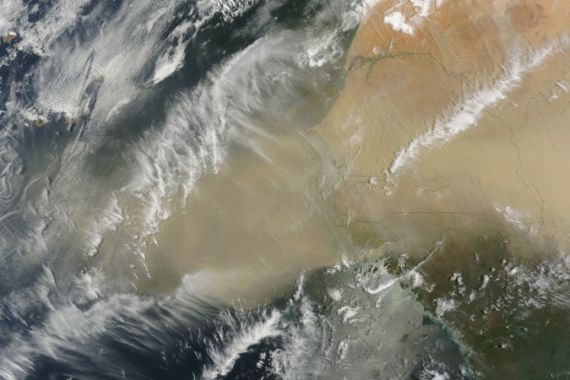Saharan dust spreads far and wide
The many effects of dust originating in the Sahara

 Dust blowing from the Sahara into the Atlantic Ocean [NASA]
Dust blowing from the Sahara into the Atlantic Ocean [NASA]
Dust storms in West Africa are a common but still spectacular occurrence – as our image from NASA confirms. Much of the region affected is sparsely populated. But interest in dust from this area, amongst the scientific community, is high.
This is because dust from the region finds its way across much of the globe. Its impacts are many and varied and often surprising.
Keep reading
list of 4 itemsTurtles swimming to extinction in Malaysia as male hatchlings feel heat
Could shipping containers be the answer to Ghana’s housing crisis?
Thousands protest against over-tourism in Spain’s Canary Islands
This dust originates in the Sahara desert, the largest source of mineral dust on Earth, covering almost eight million square kilometres. It is estimated that some 240 million tons of dust are blown from the Sahara into the Atlantic Ocean every year.
The southern boundary of the Sahara is marked by a semi-arid savanna known as the Sahel. This region is subject to periodic drought which also acts a dust source.
Dust which is raised across West Africa is thought to play a major part in drought formation across the region. The dust affects the energy balance by absorbing solar and terrestrial radiation. This, in turn, affects cloud development across the region.
The effects of the dust are not confined to the immediate area. Research also shows an effect on the hurricane season across the other side of the Atlantic Ocean.
Heat from the oceans is a major source of energy for developing hurricanes. Saharan dust can reduce the amount of solar energy reaching the ocean surface, thereby causing a cooling effect.
This is thought to have been the case during the 2006 Atlantic hurricane season when sea surface temperatures remained low and the season only spawned a total of five hurricanes, compared with an average of eight.
30 to 40 percent of the drop in sea temperatures was thought to be as a result of dust although other factors, particularly El Nino, are also significant factors.
Within the vast quantities of dust being transported across the Atlantic are various plant and animal pathogens, bacteri and fungi. Locust plagues within the Caribbean are sometimes of a Saharan origin. There are also are links between the degradation of coral reefs in the region and soil pathogens originating in the Sahara.
Saharan dust also plays a crucial role in the survival of the Amazon rainforest. The large annual rainfall across the Amazon basin tends to leach the soil; yet the vegetation thrives. How can this be?
The solution to this contradiction appears to be that the rainforest thrives because it is fertilized by some 50 million tons of Saharan dust that falls upon it every year.
Amazingly, over half of all this dust originates from a tiny area, known as the Bodele depression, a sandy valley neat Lake Chad.